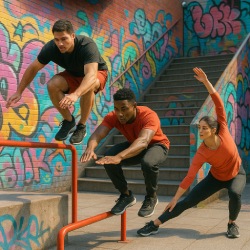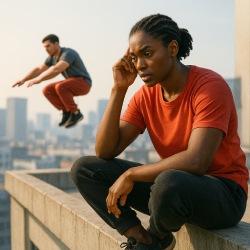The Origins and Philosophy of Parkour
At its core, parkour is the art of moving with purpose. Originating in France in the late 1980s, it evolved from Georges Hébert’s système naturel, which emphasized running, jumping, climbing, and overcoming natural obstacles. David Belle and his colleagues developed these ideas into modern parkour. The practice prioritizes efficiency—every movement serves a function, whether reaching an object, adapting, or navigating a space. Parkour is not about competition but about mastering one’s environment and mindset. Practitioners aim to move smoothly, conserve energy, and creatively transform ordinary spaces into dynamic playgrounds.
Parkour vs. Freerunning
While the words alike are so oft exchanged, from one perspective, parkour and freerunning belong to utterly different movement cultures. Parkour aims for utility and efficiency: basically, whatever makes it seem the smoothest to move from point A to point B. In freerunning, flips, spins, and other acrobatic expressions are indeed admired-this was introduced by Sébastien Foucan. Both disciplines share the same fundamentals of body control, strength, and flow, though freerunning leans somewhat more on performance and artistry.
Core Techniques and Movements
Parkour trains strength, coordination, and mental focus through fundamental movements. These also provide the base for more complex combinations and creative expressions.
Every movement is designed to solve a given physical problem: height, distance, or barrier, while sustaining flow and efficiency.
Vaults
Vaults propel a traceur over obstacles such as rails, walls, and benches while maintaining momentum. Common variations include:
- Kong Vault: Lands the hands on the obstacle while the legs tuck in and pass between the arms while in mid-air.
- Speed Vault: A faster, one-handed vault to keep up with the pace of the run.
- Dash Vault: Legs initiate the forward motion while the hands give a final push from the obstacle.
Vaulting heightens body awareness and rhythm, thus developing confidence in swift, flowing transitions.
Precision Jumps
Precision jumps necessitate controlled landings and power from explosive takeoffs. The aim is to maintain balance and power by jumping from one surface onto another, often onto narrow ledges or rails. This technique trains leg strength, spatial judgment, and concentration. A proper precision jump consists of taking off from two feet, attaining mid-air control, and then landing softly and balanced on the balls of the feet.
Wall Runs and Climbs
Wall scaling is one of the core applications of parkour. Wall run: run up a vertical wall, then latch on to the lip with momentum. From here, the climb up is a sort of pull-and-push action to get over the ledge. These very skills help build upper arm strength, coordination, and timing. One should learn to safely approach differing surfaces if they are to move effectively in varied environments.
Rolls and Landings
A landing has to be one that minimizes impact while preserving the flow. Parkour landing is soft, quiet, and controlled, with arms allowed to touch the ground before the knees bend and hips engage to absorb the force. At bigger heights, a roll distributes the impact across the body, allowing the traceur to move away so that the traceur can continue his movements. Doing rolls properly is a challenge without practice, especially over various surfaces.
Flow and Linking Movements
Flow is what transforms technique into art. It is the ability to link movements one into the next naturally and without any hesitation. Flow considers rhythm, adaptability, and situational awareness, traits considered as advanced in practitioners. Training flow includes improvisation to be able to adapt in the moment while remaining composed and in control.
Conditioning and Strength Training
Parkour is built on bodyweight control. Conditioning drills include pull-ups, push-ups, dips, squats, lunges, and core exercises-for all the functional strength jumps need, vaults need, climbs need. Plyometric exercises such as box jumps and explosive push-ups are useful to develop the power needed for dynamic movement.
Balance and Coordination
Balance is one very prominent factor when training parkour. A traceur may train by balancing on a railwalk, curb, or a very thin wall. These training exercises enhance one's proprioception and mental focus. Elementary drills, like balancing on one leg or walking on a cakewalk, develop the confidence and balance needed in performing technical maneuvers.
Spatial Awareness and Reaction
The environmental factor stimulates traceurs to be spontaneous in their movements. Training in different environments, urban or natural landscapes, or gyms, serves to augment how well one judges distances and reacts. Such drills as "following the leader" or timed runs on obstacles enhance their decision skills under pressure, simulating their real-life challenges of moving about.
Safety, Progression, and Injury Prevention
This free movement in parkour comes with its own set of responsibilities. Acknowledging and observing principles of safety should assure sustainability of growth and diminution of risk.

Warm-Up and Mobility
A solid warm-up ensures the prep for muscles, joints, and the nervous system on any given day. Dynamic stretches, rotations of the joints, and an easy jog up will increase the circulation and prevent injuries by encouraging flexibility. Mobility drills for the hips, ankles, and shoulders work on increasing flexibility so that one can move more smoothly and safely.
Progression and Scaling
Every parkour technique has a scaled-down version. Beginners can practice simply by engaging with low vaults or short jumps until advanced variations are within their grasp. The basis of the progression should be about control and consistency-carbon-copy standards really, rather than height or difficulty. The worker should become very good at the basic skills before they set to manifolds and enhance their confidence incrementally.
The Mental Side of Parkour
Parkour is a methodology that trains the mind to conquer fear, doubt, and hesitation somehow beyond mere physical skills. It is a self-observing and problem-solving exercise that transcends movement.
Every obstacle, literal or figurative, becomes an opportunity for growth and learning.

Overcoming Fear
With any risk or danger, fear is instantaneously thrown up into us as a natural impulse. Fear in parkour is taken care of through preparation and trust in training methods. Visualizing a good outcome, breaking down a skill into smaller parts, and going through a series of safe progressions all instill confidence. Over time, a practitioner discovers how fear can be converted into concentration.
Adaptability and Problem-Solving
Creativity is panic for the improvisation of parkour. You never are the same environment, so from one environment to another, one must be quick in thought and decisive in action This inculcates a certain kind of resilience-less tolerance through which a person stays calm and is able to act even under pressure. The same mental swiftness, however, are used to tackle life's everyday problems, thus making parkour a way of life as much as a form of exercise.
Mastering Skills Through Consistent Practice
Parkour progress comes from deliberate, consistent training. Traceurs refine techniques not through speed but through repetition, focus, and mindful movement. Practicing vaults, precision jumps, wall climbs, and rolls under varied conditions develops muscle memory, confidence, and situational awareness. Conditioning exercises, balance drills, and mobility work complement technical skills, ensuring the body is prepared for challenges. Advanced practitioners experiment with linking movements and improvisation to enhance flow. Over time, these habits cultivate resilience, creativity, and adaptability, allowing athletes to approach obstacles with calm problem-solving rather than force. Mastery emerges gradually, grounded in patience, consistency, and respect for one’s limits.
Flow, Freedom, and Fearlessness
Parkour is a developing art of athletic precision and creative and mental discipline that teaches control and adaptation while developing courage to transcend limitations, whether physical or mental.
From the urban landscape into cinematic performances, parkour continues to inspire people to explore their world through movement. According to 3RUN philosophy, the real skill is not in conquering obstacles but rather in learning to move with intent, awareness, and freedom.